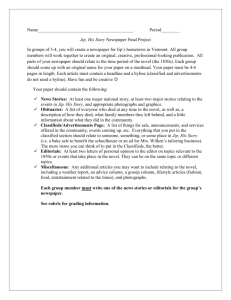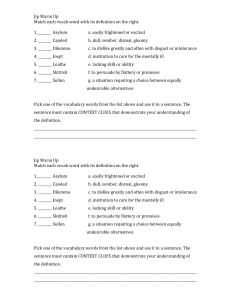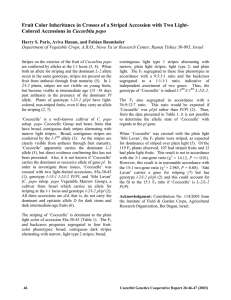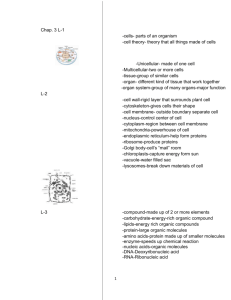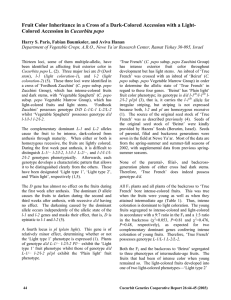Inheritance of Rind Color and Reverse Striping in a Cucurbita pepo
advertisement
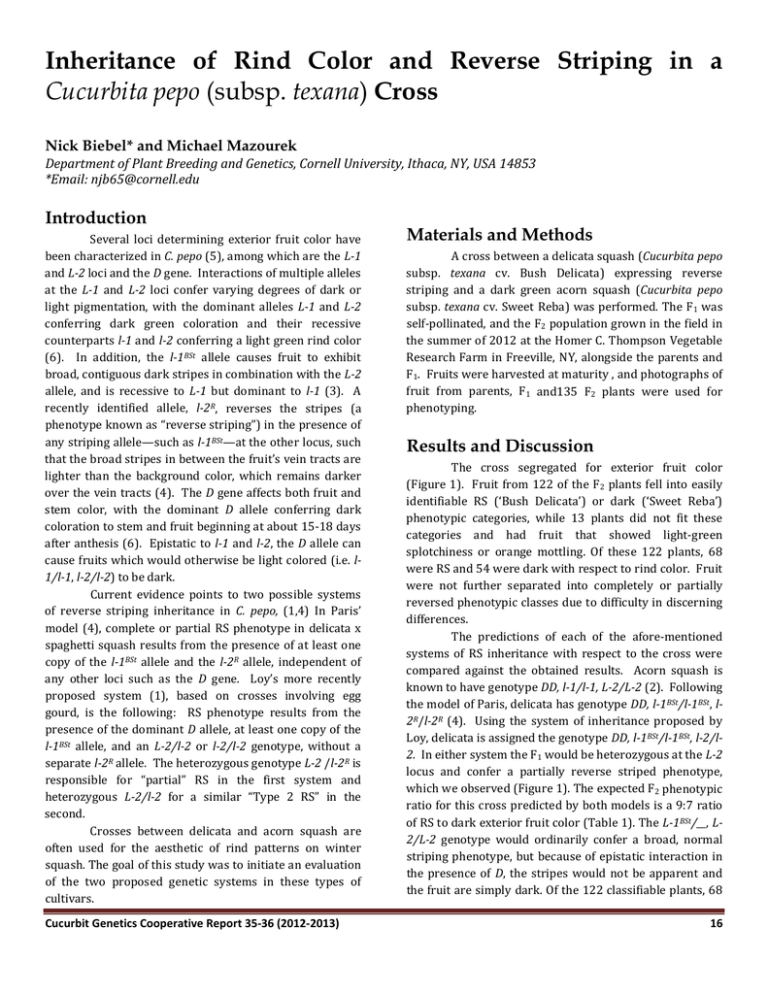
Inheritance of Rind Color and Reverse Striping in a Cucurbita pepo (subsp. texana) Cross Nick Biebel* and Michael Mazourek Department of Plant Breeding and Genetics, Cornell University, Ithaca, NY, USA 14853 *Email: njb65@cornell.edu Introduction Several loci determining exterior fruit color have been characterized in C. pepo (5), among which are the L-1 and L-2 loci and the D gene. Interactions of multiple alleles at the L-1 and L-2 loci confer varying degrees of dark or light pigmentation, with the dominant alleles L-1 and L-2 conferring dark green coloration and their recessive counterparts l-1 and l-2 conferring a light green rind color (6). In addition, the l-1BSt allele causes fruit to exhibit broad, contiguous dark stripes in combination with the L-2 allele, and is recessive to L-1 but dominant to l-1 (3). A recently identified allele, l-2R, reverses the stripes (a phenotype known as “reverse striping”) in the presence of any striping allele—such as l-1BSt—at the other locus, such that the broad stripes in between the fruit’s vein tracts are lighter than the background color, which remains darker over the vein tracts (4). The D gene affects both fruit and stem color, with the dominant D allele conferring dark coloration to stem and fruit beginning at about 15-18 days after anthesis (6). Epistatic to l-1 and l-2, the D allele can cause fruits which would otherwise be light colored (i.e. l1/l-1, l-2/l-2) to be dark. Current evidence points to two possible systems of reverse striping inheritance in C. pepo, (1,4) In Paris’ model (4), complete or partial RS phenotype in delicata x spaghetti squash results from the presence of at least one copy of the l-1BSt allele and the l-2R allele, independent of any other loci such as the D gene. Loy’s more recently proposed system (1), based on crosses involving egg gourd, is the following: RS phenotype results from the presence of the dominant D allele, at least one copy of the l-1BSt allele, and an L-2/l-2 or l-2/l-2 genotype, without a separate l-2R allele. The heterozygous genotype L-2 /l-2R is responsible for “partial” RS in the first system and heterozygous L-2/l-2 for a similar “Type 2 RS” in the second. Crosses between delicata and acorn squash are often used for the aesthetic of rind patterns on winter squash. The goal of this study was to initiate an evaluation of the two proposed genetic systems in these types of cultivars. Cucurbit Genetics Cooperative Report 35-36 (2012-2013) Materials and Methods A cross between a delicata squash (Cucurbita pepo subsp. texana cv. Bush Delicata) expressing reverse striping and a dark green acorn squash (Cucurbita pepo subsp. texana cv. Sweet Reba) was performed. The F1 was self-pollinated, and the F2 population grown in the field in the summer of 2012 at the Homer C. Thompson Vegetable Research Farm in Freeville, NY, alongside the parents and F1. Fruits were harvested at maturity , and photographs of fruit from parents, F1 and135 F2 plants were used for phenotyping. Results and Discussion The cross segregated for exterior fruit color (Figure 1). Fruit from 122 of the F2 plants fell into easily identifiable RS (‘Bush Delicata’) or dark (‘Sweet Reba’) phenotypic categories, while 13 plants did not fit these categories and had fruit that showed light-green splotchiness or orange mottling. Of these 122 plants, 68 were RS and 54 were dark with respect to rind color. Fruit were not further separated into completely or partially reversed phenotypic classes due to difficulty in discerning differences. The predictions of each of the afore-mentioned systems of RS inheritance with respect to the cross were compared against the obtained results. Acorn squash is known to have genotype DD, l-1/l-1, L-2/L-2 (2). Following the model of Paris, delicata has genotype DD, l-1BSt/l-1BSt, l2R/l-2R (4). Using the system of inheritance proposed by Loy, delicata is assigned the genotype DD, l-1BSt/l-1BSt, l-2/l2. In either system the F1 would be heterozygous at the L-2 locus and confer a partially reverse striped phenotype, which we observed (Figure 1). The expected F2 phenotypic ratio for this cross predicted by both models is a 9:7 ratio of RS to dark exterior fruit color (Table 1). The L-1BSt/__, L2/L-2 genotype would ordinarily confer a broad, normal striping phenotype, but because of epistatic interaction in the presence of D, the stripes would not be apparent and the fruit are simply dark. Of the 122 classifiable plants, 68 16 were RS and 54 were dark—results consistent with either model (χ2 = 0.013, p= 0.9092). The difference between the two systems involves the D gene and the existence of the l-2R allele. Loy, in his crosses, found that the dominant D allele was necessary to confer the RS phenotype (1), whereas Paris found RS exhibited even in crosses involving only light-stemmed (dd) plants (4). Differences in these systems may be a result of the different parents used for crossing (H. Paris, personal communication). Because of the nature of our cross, especially its lack of segregation for the D gene, clarification regarding the inheritance of RS and the role of the D gene in reverse striping in C. pepo cannot be further elucidated using our current data. Additional crosses and plantings are planned. 1. 2. 3. 4. 5. 6. Loy, J.B. 2012. Introgression of genes conferring the bush habit of growth and variation in fruit rind color into white nest egg gourd. In N. Sari, I. Solmaz, and V. Aras (Eds.) Proceedings of the Xth EUCARPIA Meeting on Genetics and Breeding of Cucurbitaceae. Antalya, Turkey, Cukurova University, pp. 275-282. Paris, H. S. 1997. Genes for developmental fruit coloration of acorn squash. J. Hered. 88(1), 52-56. Paris, H.S. 2000. Gene for broad, contiguous dark stripes in cocozelle squash. Euphytica 115: 191-196. Paris, H. 2009. Genes for “reverse” striping in squash (Cucurbita pepo). J. Hered. 100(3): 371-379. Paris, H.S., and E. Kabelka. 2009. Gene list for Cucurbita species, 2009. Cucurbit Genetics Cooperative Report 31-32: 44-69. Paris, H.S., and H. Nerson. 1986. Genes for intense pigmentation of squash. J. Hered. 77: 403-409. Literature Cited Table 1. Expected genotypic frequencies and associated phenotypes of the F2 population given two systems of reverse striping Genotype: Genotype: D-Independent Model D-Dependent Model Frequency Phenotype DD, L-1BSt/__, L-2/L-2 DD, L-1BSt/__, L-2/L-2 3/16 dark DD, L-1BSt/__, L-2/l-2R DD, L-1BSt/__, L-2/l-2 6/16 RS (partial/Type 2) DD, L-1BSt/__, l-2R/l-2R DD, L-1BSt/__, l-2/l-2 3/16 RS (complete/Type 1) DD, l-1/l-1, L-2/L-2 DD, l-1/l-1, L-2/L-2 1/16 dark DD, l-1/1-1, L-2/l-2R DD, l-1/1-1, L-2/l-2 2/16 dark DD, l-1/l-1, l-2R/l-2R DD, l-1/l-1, l-2/l-2 1/16 dark Cucurbit Genetics Cooperative Report 35-36 (2012-2013) 17
